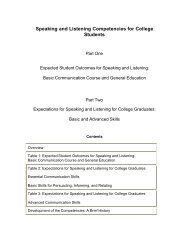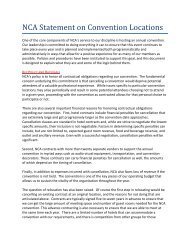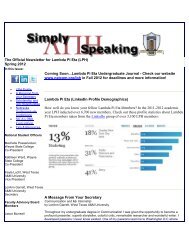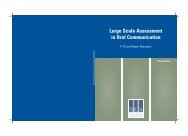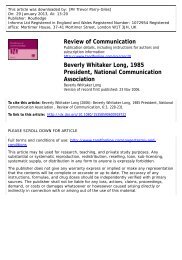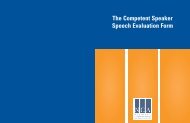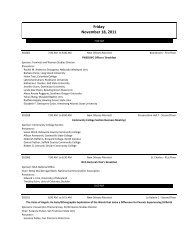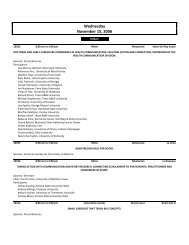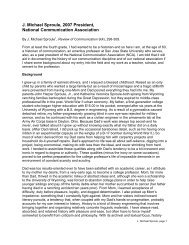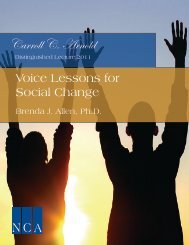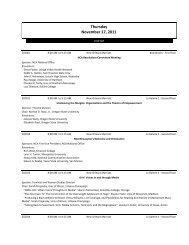ingness <strong>to</strong> communicate: A comparison with first andsecond languages in Micronesia. <strong>Communication</strong>Research Reports, 20(3), 230-239.Research involving communication apprehension(CA) and related constructs such as self-perceived communicationcompetence (SPCC) and willingness <strong>to</strong>communicate (WTC) has been conducted in a wide varietyof cultures. In general, relationships among thesevariables have been found <strong>to</strong> be quite similar across cultures,even when substantial mean differences have beenobserved. An exception <strong>to</strong> this pattern was an extremelyhigh (r =.80) correlation between SPCC and WTC observedin a study conducted in Micronesia (Burroughs& Marie, 1990). Other relationships observed in thestudy were generally consistent with those found inother cultures. Since this study involved individuals ina context where they were forced <strong>to</strong> communicate in asecond language much of the time, and the data werecollected in that second language, it was suspected thisanomaly was what produced the aberrant finding. Thepresent study obtained data from the same populationbut referenced the participants’ first languages and wasadministered in their first language. Results indicated arelationship between SPCC and WTC consistent withthat found in other cultures. It was also observed that,while there was substantially lower perceived communicationcompetence for the second language than forthe first language, there was no such differential forcommunication apprehension.Rancer, A., & Yang, L. (2003). Ethnocentrism, interculturalcommunication apprehension, interculturalwillingness-<strong>to</strong>-communicate, and intentions <strong>to</strong> participatein an intercultural dialogue program: Testinga proposed model. <strong>Communication</strong> Research Reports,20(2), 189-190.The article focuses on a model on ethnocentrism andintercultural communication apprehension, interculturalwillingness-<strong>to</strong>-communicate (IWTC) and intentions<strong>to</strong> participate in an intercultural dialogue program.Results of the study suggest that the proposed modelrefinement. The data suggest a modified model refinementthat argues that ethnocentrism and interculturalcommunication apprehension are related. It also arguesthat ethnocentrism and intercultural communicationapprehension are both related <strong>to</strong> IWTC. Ethnocentrismand IWTC are related <strong>to</strong> intentions <strong>to</strong> participatein cultural exchange program. Thus IWTC is influencedby both ethnocentrism and intercultural communicationapprehension. Both ethnocentrism and IWTC have adirect influence on individuals’ intentions <strong>to</strong> participatein intercultural dialogue program. The implication ofthis finding is that if one wants <strong>to</strong> get an estimate ofan individual’s intentions <strong>to</strong> participate in such programor other intercultural encounter, it would be prudent <strong>to</strong>measure ethnocentrism and IWTC.Donavan, L. & MacIntyre, P. (2004). Age and sex differencesin willingness <strong>to</strong> communicate, communicationapprehension, and self-perceived competence.<strong>Communication</strong> Research Reports. 21(4), 420-427.Age and sex differences in willingness <strong>to</strong> communicate(WTC), communication apprehension, and selfperceivedcommunication competence were examinedusing three age cohorts of participants drawn from juniorhigh, high school, and university student populations.Results indicate that junior high females are higher inWTC than their male counterparts and females at theuniversity level are higher in communication apprehensionand lower in self-perceived competence than aremale university students. <strong>Communication</strong> apprehensionand self-perceived competence show a consistent negativerelationship that does not vary with age or sex in thepresent sample. The degree <strong>to</strong> which communicationapprehension and self-perceived competence predictWTC varies with age and sex. In all three age cohorts,communication apprehension is a significant predic<strong>to</strong>rof WTC among women. Among men, self-perceivedcompetence emerges as a significant predic<strong>to</strong>r of WTCin all three age groups.<strong>Assessing</strong> <strong>Motivation</strong> <strong>to</strong> <strong>Communicate</strong> 23
THE NATIONAL COMMUNICATION ASSOCIATION’SCRITERIA FOR THE ASSESSMENT OF ORAL COMMUNICATIONA <strong>National</strong> ContextAssessment has received increasing attention throughoutthe 1970s and in<strong>to</strong> the 1990s. Initially appearing inthe standards developed by state depart-mints of education,by 1980 over half of the states had adopted statewidestudent-testing programs. In Educational Standardsin the 50 States: 1990, the Educational TestingService reported that by 1985, over 40 states had adoptedsuch programs, and between 1985 and 1990, anadditional five states initiated statewide student- testingprograms, bringing the number of such program <strong>to</strong> 47.During the 1970s and 1980s, the number of differentsubjects and skills tested has also consistently increased,with additional attention devoted <strong>to</strong> how assessmentsare executed. Moreover, during this period, organizations,such as the <strong>National</strong> Assessment of EducationalProgress, intensified and expanded the scope of their assessmentprocedures as well as extensively publicizedthe results of their findings nationally and annually.By the end of 1989, the public recognized the significanceof national educational assessments. In the PhiDelta Kappan-Gallup poll reported in the September1989 issue of Phi Delta Kappan, 77 percent of the respondentsfavored “requiring the public schools in thiscommunity <strong>to</strong> use standardized national testing programs<strong>to</strong> measure academic achievement of students,”and 70 percent favored “requiring the public schoolsin this community <strong>to</strong> conform <strong>to</strong> national achievementstandards and goals.”Likewise, <strong>to</strong>wards the end of the 1980s, colleges anduniversities began <strong>to</strong> realize that formal assessment issueswere <strong>to</strong> affect them. For example, in its 1989-1990Criteria for Accreditation, the Southern Association ofColleges and Schools--which provides institutional certificationfor over 800 colleges and universities in theSouth-held that “complete requirements for an associateor baccalaureate degree must include competence inreading, writing, oral communications and fundamentalmathematical skills.” They also held that the generaleducation core of colleges and universities “mustprovide components designed <strong>to</strong> ensure competence inreading, writing, oral communication and fundamentalmathematical skills.”In 1990, a series of reports appeared which suggestedthat systematic and comprehensive assessment shouldbecome a national educational objective. In February1990, for example, the <strong>National</strong> Governors’ Association,in the context of President George H.W. Bush’s se<strong>to</strong>f six educational goals, argued that, “<strong>National</strong> educationgoals will be meaningless unless progress <strong>to</strong>wardmeeting them is measured accurately and adequately,and reported <strong>to</strong> the American people.” The nation’sgovernors argued that “doing a good job of assessment”requires that “what students need <strong>to</strong> know mustbe defined,” “it must be determined whether they knowit,” and “measurements must be accurate, comparable,appropriate, and constructive.” In July 1990, PresidentBush reinforced this line of reasoning in The <strong>National</strong>Education Goals: A Report <strong>to</strong> the Nation’s Governors.And, in September 1990, the <strong>National</strong> Governors Associationextended and elaborated its commitment <strong>to</strong>assessment in Educating America: State Strategies forAchieving the <strong>National</strong> Education Goals: Report of theTask Force on Education.Additionally, in 1990, in their report From Gatekeeper<strong>to</strong> Gateway: Transforming Testing in America,the <strong>National</strong> Commission on Testing and Public Policyrecommended eight standards for assessment, arguingfor more humane and multicultural assessment systems.Among other considerations, they particularlymaintained that “testing policies and practices must bereoriented <strong>to</strong> promote the development of all human talent,”that “test scores should be used only when theydifferentiate on the basis of characteristics relevant <strong>to</strong>the opportunities being allocated, and that “the moretest scores disproportionately deny opportunities <strong>to</strong> minorities,the greater the need <strong>to</strong> show that the tests measurecharacteristics relevant <strong>to</strong> the opportunities beingallocated.”NCA’s Assessment ActivitiesThe evaluation and assessment of public address hasbeen of central concern <strong>to</strong> the discipline of communicationsince its inception and <strong>to</strong> the <strong>National</strong> <strong>Communication</strong>Association when it was organized in 1914. In 1970,NCA formalized its commitment <strong>to</strong> assessment when itcreated the Committee on Assessment and Testing (nowknown by the acronym CAT) for “NCA members interestedin gathering, analyzing and disseminating informationabout the testing of speech communication24 <strong>Assessing</strong> <strong>Motivation</strong> <strong>to</strong> <strong>Communicate</strong>




